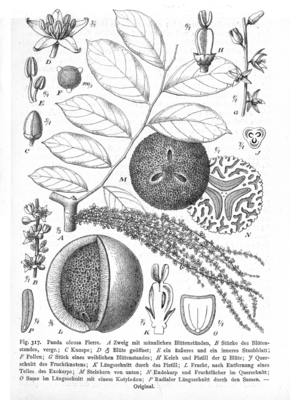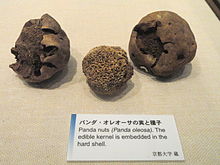Panda oleosa
| Panda oleosa | ||||||||||||
|---|---|---|---|---|---|---|---|---|---|---|---|---|

Illustration of panda oleosa |
||||||||||||
| Systematics | ||||||||||||
|
||||||||||||
| Scientific name of the genus | ||||||||||||
| panda | ||||||||||||
| Pierre | ||||||||||||
| Scientific name of the species | ||||||||||||
| Panda oleosa | ||||||||||||
| Pierre |
Panda oleosa is a tree in the Pandaceae family from central to western Africa . It is the only species in the genus panda .
description
Panda oleosa grows as a slow-growing, evergreen tree with a dense crown to about 35 meters or a little more. The trunk diameter reaches 80-100 centimeters. Smaller buttress roots are formed. The smooth bark is grayish and easily cracked.
The simple, short-stalked, leathery and bare leaves are alternate. The short rutty petiole is 0.5-1.5 inches long. The ovate to elliptical and acuminate to acuminate, serrated on the edge leaves are 10-30 centimeters long and 4-13 centimeters wide. The small stipules are sloping.
Panda oleosa is dioecious diocesan . Long, racemose inflorescences are formed, which appear singly or in clusters. The stalked, very small flowers are five-fold with a double flower envelope . The flower stalk, up to 4 millimeters long, is divided with a "joint". The 1 millimeter long, tiny calyx is cup-shaped with minimal teeth. The red, 5 millimeter long petals are free, expansive and elliptical to eilanzettlich. The male flowers have 10 stamens of unequal length , with thick stamens, in two circles, the outer ones are longer, and a pestle. The female flowers have a permanent top, three, vierkammerigen, -kantigen ovary with minimal style with several large stigma lobes .
Roundish 5–7 centimeters, green to yellowish and multi-seeded drupes are formed. The woody, 3–4-seeded stone core, with a thick, very hard shell, is pitted and rough textured. The roughly triangular, slightly concave, thin and brown, smooth seeds are up to 2 centimeters long. The flesh is orange-reddish.
Taxonomy
The first description of the genus Panda and the species Panda oleasa was in 1896 by Jean Baptiste Louis Pierre in Bull. Mens. Soc. Linn. Paris 2: 1255.Synonyms are Sorindeia rubiflora Engl. , Porphyranthus zenkeri Engl.
use
The cooked seeds are edible and an edible oil is made from them . They are used in a manner similar to that of Irvingia gabonensis .
The bark , roots, leaves and the seed oil are used medicinally.
The medium-weight wood can be used for some applications.
literature
- Quentin Meunier, Carl Moumbogou, Jean-Louis Doucet: Les arbres utiles du Gabon. Presses Agronomiques de Gembloux, 2015, ISBN 978-2-87016-134-0 , p. 254 f, limited preview in the Google book search.
Web links
- Panda oleasa at PROTA.
- Panda oleosa at Useful Tropical Plants.
- Panda oleosa . In: S. Dressler, M. Schmidt, G. Zizka (Eds.): African plants - A Photo Guide. Senckenberg, Frankfurt / Main 2014.
